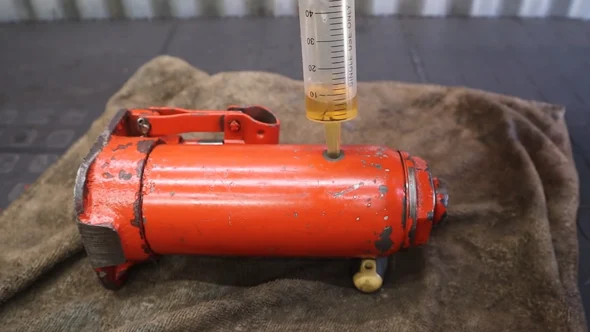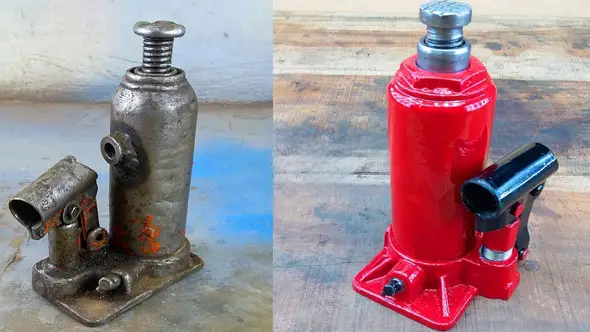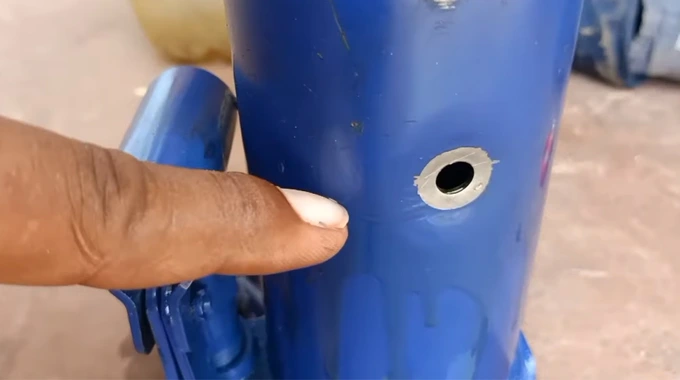Last Updated on April 20, 2023
A bottle jack is a hydraulic jack that uses a piston and cylinder arrangement to raise vehicles for various maintenance tasks, but they can develop leaks over time. If the jack is not sealed correctly, hydraulic fluid can leak from the piston area and cause the jack to lose its lifting power. But why does the bottle jack leak?
The jack consists of a pump, release valve, and hydraulic cylinder, all housed in a metal body. A broken seal can leak hydraulic fluid over time when it gets worn out or broken. Occasionally, the leaky fluid can also cause the jack to overheat, resulting in further leakage.
If you suspect your bottle jack is leaking, it should be serviced as soon as possible. Otherwise, you may harm the jack further or may suffer an injury. Please read on to learn more about why and how bottle jacks leak.
Why Does My Bottle Jack Leak: Reasons Explained

Any mechanical device that uses hydraulic fluid will have the potential for leaks. Usually, the leak comes from the hydraulic fluid used to power the jack. In a bottle jack, there are some primary areas where leaks can occur:
Broken or Worn Piston Seal
When a piston seal is broken or worn, it can cause the bottle jack to leak. The piston seal is a critical component of the jack and helps keep fluid from leaking out of the cylinder. If this seal is damaged, fluid can escape from the cylinder, causing the jack to lose pressure and become less effective.
In some cases, a broken piston seal may also lead to jack failure. New-condition jacks can also suffer from this problem due to improper installation or exceeding the rated load capacity. A broken piston seal can be a severe problem that can ultimately lead to the failure of the entire jack.
Faulty Bypass Valve
When a bottle jack starts to leak, it’s often because the bypass valve is faulty. The bypass valve allows pressure to build up in the jack, and if it’s not functioning properly, the jack will start to leak.
There are several ways to tell if the bypass valve is the problem:
- If you can’t get any pressure in the jack after bleeding it, the bypass valve is likely the problem.
- If it doesn’t start leaking until you use the bypass valve, that’s a good indication that the valve is the problem.
If you suspect the bypass valve is faulty, you can try replacing it. This is often a simple fix and should help resolve the leaking issue. But if the leak persists after replacing the valve, other problems with your bottle jack must be addressed.
Loose Fill Spout
A filling spout is located on the side of the jack and is used to add fluid to the chamber. If this spout is not tightened correctly, it can leak, causing the jack to lose its hydraulic pressure and preventing it from working correctly.
Also, this spout is the most likely spot for a leak since it is constantly exposed to air and moisture. If the fluid is leaking from the fill spout, simply tighten the cap to see if that stops the leak. If the leak persists, consider replacing the O-ring on the spout.
Loose Packing Nut
The packing nut is located at the base of the jack, where the piston rod enters the pump body. Its purpose is to seal the gap between the piston rod and the pump body, preventing fluid from leaking.
But if the packing nut is loose, it can no longer provide an adequate seal, allowing fluid to leak. In some cases, a loose packing nut can also cause the piston rod to seize, preventing the jack from being able to raise or lower.
These are some of the most common reasons a bottle jack might leak. To prevent leaks, check for damage regularly, and be sure to replace parts as necessary.
Are Bottle Hydraulic Jacks Normally Prone to Leaks?
Because bottle hydraulic jacks rely on hydraulic fluid for operation, they are subject to leaks usually as time passes. The seals between the piston and the cylinder walls can wear down, allowing fluid to escape.
While you cannot wholly prevent leaks, you should regularly check for them and repair any damage as soon as possible to avoid costly repairs or downtime.
Do You Need to Bleed a Bottle Jack to Fix a Leak?

To fix a leak in a bottle jack, it may need to bleed depending on the severity of the leak. If the leak is slight, then you may be able to add more fluid to the reservoir simply. But, if the leak is more significant, you need to bleed the jack. This will ensure that the proper fluid is pumped into the cylinder.
The most effective way to bleed a bottle jack is relatively simple, but you must follow the instructions carefully to avoid damaging the jack. Once you have bled the jack, you should be able to use it without further leaking.
In any case, if the problem continues, you may need to replace the seals or O-rings in the cylinders. Typically, bleeding a bottle jack is necessary to fix a leak. If the problem is more severe, you may need to take additional steps to repair the jack.
Is it Possible to Overfill a Bottle Jack After Fixing a Leak?
Yes, it is possible to over-fill a bottle jack after repairing a leak. The most likely scenario would be if you did not bleed the air out of the system after fixing the leak. This would cause pressure in the system and cause the seals to fail.
Overfilling a bottle jack can cause the jack to malfunction or even explode. To avoid this, ensure the jack’s fluid level is at the manufacturer’s specified capacity. Following those simple guidelines ensures that your bottle jack will always work safely and effectively.
Can You Lay a Leaky Bottle Jack on its Side When Repairing Leaks?

Some believe it is safe to lay a bottle jack on its side when performing leaking repairs. But this is not the case. When bleeding the system, ensure that you never lay the unit on its side, as this can cause jack oil to leak out of the unit. For this reason, placing a bottle jack upright is always best when repairing it.
When attempting to repair a leaky bottle jack, one of the first things you will need to do is remove the hydraulic jack oil fill cap and check the oil level inside the unit. If the oil level is low, you must add more jack oil until it reaches the full line. Once the hydraulic oil level is correct, it is safe to begin your repairs.
Can Leaky Hydraulic Bottle Jacks Fail?
When a bottle jack leaks, it can lose its ability to generate enough pressure to lift the heavy load, causing the load to come crashing down. When hydraulic fluid leaks out, it reduces the jack’s lifting capacity and can eventually cause it to fail.
In some cases, the piston can also become stuck in the lower chamber, making it impossible to lower the jack. Thus, checking for leaks and damage before using a bottle jack and repairing or replacing any damaged parts is important.
Is It Better to Repair or Replace Leaky Bottle Jack?
It is better to replace a leaky bottle jack instead of repairing it because a leaky jack is a safety hazard. Leaking hydraulic fluid can lead to decreased stability and uneven weight distribution.
The leak puts the user and the lifted vehicle at risk of accidents. It can also lead to mechanical failure, resulting in injuries, property damage, or even death.
Replacing a leaky bottle jack ensures the safety and stability of the lifted vehicle and the user. It eliminates the risk of accidents or mechanical failure due to a faulty jack. A new bottle jack typically comes with a warranty, giving the user peace of mind and protection in case of defects.
Get the highest lifting capacity for your lifted truck without breaking the bank. We have reviewed the most affordable bottle jack for lifted trucks, boasting an impressive lifting capacity and increased stability that ensures safety and durability.
How Do You Keep Your Hydraulic Bottle Jack Leak-Free?
Whether changing a tire or performing routine maintenance, a hydraulic bottle jack can make the job much easier. But leaks are common problems with hydraulic jacks, and even a small leak can render the jack unusable.
Luckily, you can take a few simple steps to keep your jack leak-free:
- Ensure that the O-ring and dust cover are in good condition and properly seated.
- Check the base of the jack for any cracks or damage.
- Keep the fluid level topped off and regularly bled the system’s air.
Keeping it clean and free of debris is essential. You can use a soft cloth to wipe down the jack’s surface regularly. A seal or O-ring that is worn or damaged should also be checked.
If you notice any cracks or leaks, you’ll need to replace the seals and O-rings as soon as possible. It is always a good idea to store your hydraulic bottle jack in a dry, cool place. This will help to prevent corrosion and extend the life of the jack.
